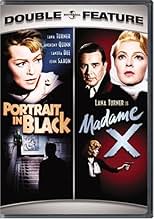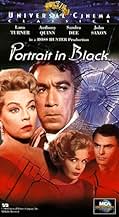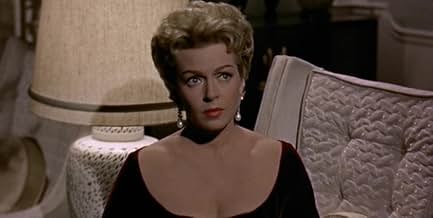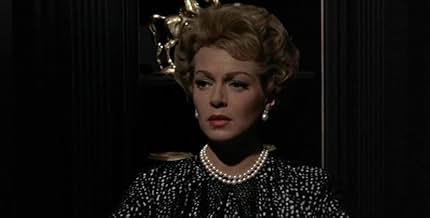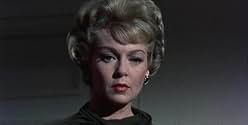IMDb रेटिंग
6.3/10
2 हज़ार
आपकी रेटिंग
एक विवाहित महिला और उसके प्रेमी ने उसके क्रूर पति की हत्या के बाद, वे खुद को किसी ऐसे व्यक्ति द्वारा लक्षित पाते हैं जो अपने अपराध से अवगत है.एक विवाहित महिला और उसके प्रेमी ने उसके क्रूर पति की हत्या के बाद, वे खुद को किसी ऐसे व्यक्ति द्वारा लक्षित पाते हैं जो अपने अपराध से अवगत है.एक विवाहित महिला और उसके प्रेमी ने उसके क्रूर पति की हत्या के बाद, वे खुद को किसी ऐसे व्यक्ति द्वारा लक्षित पाते हैं जो अपने अपराध से अवगत है.
फ़ीचर्ड समीक्षाएं
Lana Turner plays Sheila Cabot. She's unhappily married to a mean, old and rich man who treats her like that. She's having a secret affair with his doctor (Anthony Quinn). They plan and inject a lethal air bubble into her husband killing him. She gets all his money. They think they've gotten away with it till Turner receives a note in the mail saying, "Congratulations on the success of your murder". Who knows it and what do they want. A young Sandra Dee and John Saxon are mixed up in this.
The plot is OK, it LOOKS great and Turner is always dressed to the 9s but this fails utterly. It has terrible dialogue--truly laughable. The acting doesn't help, Turner--a wonderful actress--gives a lousy performance. Quinn is seriously miscast and out of his depth. Saxon and Dee are good but are hardly in it. There's also a totally ridiculous but fun plot twist at the end. This was (understandably) a box office failure but is now considered a camp classic. Proceed at your own risk.
The plot is OK, it LOOKS great and Turner is always dressed to the 9s but this fails utterly. It has terrible dialogue--truly laughable. The acting doesn't help, Turner--a wonderful actress--gives a lousy performance. Quinn is seriously miscast and out of his depth. Saxon and Dee are good but are hardly in it. There's also a totally ridiculous but fun plot twist at the end. This was (understandably) a box office failure but is now considered a camp classic. Proceed at your own risk.
Portrait in Black (1960)
In a beautifully drippy, bleeding, sticky Douglas Sirk mode, and one year after leading lady Lana Turner appeared in Sirk's "Imitation of Life," this highly slick and artificial (and yet moving) melodrama is one of the high points in a low period of Hollywood. The other main character is Anthony Quinn, who is remarkable, too, one of those underrated leading men, I'm not sure why. The two of them are supported by Richard Basehart as a fascinating and chilling underling with a peculiar mysterious cheerfulness, and Sandra Dee, who plays the spoiled daughter all too well (as you can imagine).
Unlike Sirk's dramas, this one, directed by is not just about normal human dramas (soap opera stuff), but adds a criminal and suspense element that kicks in after half an hour. The throbbing music takes on a different meaning here, and the sobbing and regrets make for an intense ride.
The deeper you get into this movie, the deeper the plot gets, with intrigue and worry and more murder mounting. And it's all filmed with fluid, rich, widescreen color photography, with intensely rendered music (that holds nothing back), and with a subtle kind of attention to nuance that oddly adds to the excesses of the plot.
And it's the plot, the story, that is so finely tuned it sustains all this cinematic swaying. It's not like some movies where the music or the photography drives the plot--here they are woven together really well, artfully and emphatically. Quinn and Turner are both extraordinary, lifting what could have been a soap opera to something completely fuller.
Russell Metty, behind the camera, was at the peak of his career, having shot not only "Imitation of Life" the year before but Sirk's early "Written on the Wind" (and moving on quickly to several masterpieces like "Spartacus" and "The Misfits"). And in fact the composer, veteran Frank Skinner, wrote the music for those two classic Sirk films, as well. It's worth stressing all this because Sirk has a huge (and deserved) following, and I have a feeling this one is just under the radar of Sirk fans. If a great Sirk film seems to almost reference itself the way it becomes so perfectly "arch" in its stereotypes, "Portrait in Black" does maintain a sense of being still a film wanting to move a plot idea along (these are subtle differences about style becoming affectation on purpose). But even so, the parallels are extraordinary, and this is a remarkable movie on those terms.
It's worth wondering what else, beyond Sirk, was going on around this time, and in fact, with the murder and suspense here it helps to look at Hitchcock's films "North by Northwest" (1959) and "Vertigo" (1958). Both are clearly influences in filming style, lacking only that higher level of stylized artfulness (and storytelling) that Hitch was by then such a master of. Or then, you might say, there was perhaps the influence of Sirk on Hitchcock, at least in the visual richness and fluidity (something Hitch abandoned immediately, almost making a point, this very year with "Psycho").
Anyway, if you don't mind an over the top melodrama done to perfection, here you go. And for movie fans, check out Anna May Wong's last film appearance (not a great performance, but she's her own legend). See it on the biggest screen you can, too--this doesn't translate well at all to a laptop experience.
In a beautifully drippy, bleeding, sticky Douglas Sirk mode, and one year after leading lady Lana Turner appeared in Sirk's "Imitation of Life," this highly slick and artificial (and yet moving) melodrama is one of the high points in a low period of Hollywood. The other main character is Anthony Quinn, who is remarkable, too, one of those underrated leading men, I'm not sure why. The two of them are supported by Richard Basehart as a fascinating and chilling underling with a peculiar mysterious cheerfulness, and Sandra Dee, who plays the spoiled daughter all too well (as you can imagine).
Unlike Sirk's dramas, this one, directed by is not just about normal human dramas (soap opera stuff), but adds a criminal and suspense element that kicks in after half an hour. The throbbing music takes on a different meaning here, and the sobbing and regrets make for an intense ride.
The deeper you get into this movie, the deeper the plot gets, with intrigue and worry and more murder mounting. And it's all filmed with fluid, rich, widescreen color photography, with intensely rendered music (that holds nothing back), and with a subtle kind of attention to nuance that oddly adds to the excesses of the plot.
And it's the plot, the story, that is so finely tuned it sustains all this cinematic swaying. It's not like some movies where the music or the photography drives the plot--here they are woven together really well, artfully and emphatically. Quinn and Turner are both extraordinary, lifting what could have been a soap opera to something completely fuller.
Russell Metty, behind the camera, was at the peak of his career, having shot not only "Imitation of Life" the year before but Sirk's early "Written on the Wind" (and moving on quickly to several masterpieces like "Spartacus" and "The Misfits"). And in fact the composer, veteran Frank Skinner, wrote the music for those two classic Sirk films, as well. It's worth stressing all this because Sirk has a huge (and deserved) following, and I have a feeling this one is just under the radar of Sirk fans. If a great Sirk film seems to almost reference itself the way it becomes so perfectly "arch" in its stereotypes, "Portrait in Black" does maintain a sense of being still a film wanting to move a plot idea along (these are subtle differences about style becoming affectation on purpose). But even so, the parallels are extraordinary, and this is a remarkable movie on those terms.
It's worth wondering what else, beyond Sirk, was going on around this time, and in fact, with the murder and suspense here it helps to look at Hitchcock's films "North by Northwest" (1959) and "Vertigo" (1958). Both are clearly influences in filming style, lacking only that higher level of stylized artfulness (and storytelling) that Hitch was by then such a master of. Or then, you might say, there was perhaps the influence of Sirk on Hitchcock, at least in the visual richness and fluidity (something Hitch abandoned immediately, almost making a point, this very year with "Psycho").
Anyway, if you don't mind an over the top melodrama done to perfection, here you go. And for movie fans, check out Anna May Wong's last film appearance (not a great performance, but she's her own legend). See it on the biggest screen you can, too--this doesn't translate well at all to a laptop experience.
Adultery, murder, blackmail, and Lana Turner, what more could one ask of a Ross Hunter production? Perhaps a good script, but that would spoil the fun. "Portrait in Black" will have lovers of camp in stitches at dialog that makes daytime soaps seem Shakespearean. The overwrought emoting and melodramatic scenes are often unintentionally funny, and the plot requires Olympian leaps to cross the credibility gaps.
Lana is having an affair with Anthony Quinn, the doctor who is attending her terminally ill husband, Lloyd Nolan, a shipping magnate. Nolan's company, Cabot Lines, is evidently quite successful, because Lana's daily expenditures on wardrobe, coiffures, and makeup would likely sink a ship. The couple's palatial San Francisco home is a Ross Hunter fantasy whose upkeep could sink yet another Cabot Line vessel. Nolan's daughter from a first marriage, Sandra Dee, evidently has her stepmother's taste in clothes and manicure, while the son from his marriage to Lana has to make do with a toy airplane. Throw in a greedy business associate played by Richard Basehart; Dee's suitor, John Saxon; a chauffeur, Ray Walston; and a housekeeper, Anna May Wong; and you have a delicious cast of potential suspects to populate an Agatha Christie mystery. However, "Portrait in Black" is not a whodunit, but rather a "who knows they dun it."
Lana is the ultimate drama queen, and she is in peak form. She suffers, she screams, she cries; she is the empress of high camp. Anthony Quinn, who should have read the script before he signed the contract, plays down to his part and seems to know he has had and will have better parts. Sandra Dee appears to be studying for future Lana Turner roles, while Walston and Wong play their parts with the necessary ambiguity to keep viewers guessing their secrets.
However, despite the overacting, bad writing, and soap opera direction, "Portrait in Black" is great fun for those who love their melodramas with big budgets and great style. Even the obligatory mirror smashing has been incorporated. The movie is enormously entertaining for its sometimes howlingly funny situations, absurd lines, and the sheer pleasure of watching Lana looking and emoting at her best.
Lana is having an affair with Anthony Quinn, the doctor who is attending her terminally ill husband, Lloyd Nolan, a shipping magnate. Nolan's company, Cabot Lines, is evidently quite successful, because Lana's daily expenditures on wardrobe, coiffures, and makeup would likely sink a ship. The couple's palatial San Francisco home is a Ross Hunter fantasy whose upkeep could sink yet another Cabot Line vessel. Nolan's daughter from a first marriage, Sandra Dee, evidently has her stepmother's taste in clothes and manicure, while the son from his marriage to Lana has to make do with a toy airplane. Throw in a greedy business associate played by Richard Basehart; Dee's suitor, John Saxon; a chauffeur, Ray Walston; and a housekeeper, Anna May Wong; and you have a delicious cast of potential suspects to populate an Agatha Christie mystery. However, "Portrait in Black" is not a whodunit, but rather a "who knows they dun it."
Lana is the ultimate drama queen, and she is in peak form. She suffers, she screams, she cries; she is the empress of high camp. Anthony Quinn, who should have read the script before he signed the contract, plays down to his part and seems to know he has had and will have better parts. Sandra Dee appears to be studying for future Lana Turner roles, while Walston and Wong play their parts with the necessary ambiguity to keep viewers guessing their secrets.
However, despite the overacting, bad writing, and soap opera direction, "Portrait in Black" is great fun for those who love their melodramas with big budgets and great style. Even the obligatory mirror smashing has been incorporated. The movie is enormously entertaining for its sometimes howlingly funny situations, absurd lines, and the sheer pleasure of watching Lana looking and emoting at her best.
Portrait In Black is in many respects typical of the Ross Hunter films that rejuvenated Lana Turner's later career. If you're a fan of the genre, this one is quite entertaining, and in my opinion far superior to the previous year's terrible remake of Imitation of Life.
Portrait In Black brings us a torrid soap opera revolving around the relationship between the wife of a wealthy shipping magnate, Sheila Cabot, and her husband's physician, Dr. David Rivera. Unable to bear having only a few stolen moments for the each other, they conspire to murder Sheila's husband so they can be together. They subsequently find themselves blackmailed and must determine who is the blackmailer and how they will extricate themselves from this web of danger that continues to keep them separated.
As previous reviewers have pointed out, there are some rather silly aspects to the story, but these again are typical of the genre. For beginners, Sheila's husband Matt Cabot is said to have a hopeless terminal illness and to have been ill for many months. Thus, their motivation for murdering him is rather weak; he will soon die without any malicious intent on their part. If they really could not bear the wait, the idea proposed in the script, that they cannot just run away together because Matt Cabot would ruin Dr. Rivera's career and he would "never practice medicine again", is a rather unrealistic threat (although admittedly common in soap opera land). Dr. Rivera's home gives the impression he is already quite wealthy, it is not as though these two would be condemned to a life of poverty and want. These plot holes are exasperated by the poorly directed love scenes between David and Sheila, which consist of much-overplayed melodramatic panting, gasping, crying, and an inordinate and unnatural amount of chewing on one another's hands. Secondly, there are a few script blunders that could have been easily corrected. When Dr. Rivera requires Sheila to drive, he puts her in the car and has to explain what the gas and brake are for, yet in scene one we are told Sheila has been issued a learner's permit by the Department of Motor Vehicles. A learner's permit allows one to drive so long as another licensed driver is present, and one would obviously have to have mastered the basics of what makes the car go in order to be issued such a permit. The plot of device that Sheila "doesn't drive" would have been far more believable without the unnecessary learner's permit in the script. There are a number of similar absent-minded script errors here.
Having said that, one does not watch a period Ross Hunter soaper for realism. One watches it for drama, and the lush and beautiful feel we expect from Mr. Hunter. In this regard, Portrait does not disappoint. Our setting is upper crust Nob Hill in San Francisco. The Cabot home, with the exception of the library being inexplicably painted black, is breathtaking. Lana Turner is stunning, and of course immaculately outfitted in high class fashions, shoes, hats, furs, and jewels at all times, as is Sandra Dee in her second role as Lana Turner's daughter (well, step-daughter in this one). Drama abounds and the at times weak script is handled expertly by the well seasoned cast, including Richard Basehart, Ray Walston, Virginia Grey, Anna Mae Wong, and John Saxon. While Anthony Quinn would have been ideally suited to his role of Dr. David Rivera if the film had been made fifteen years earlier, he is so badly addled by Michael Gordon's incompetent direction in this role it makes him seem a bit past it (with the exception of Pillow Talk, none of Mr. Gordon's films are particularly well directed).
All things considered, this film easily meets its purpose, to entertain and is fun to watch if you can find it. It is not out on DVD, is no longer available on VHS, and is seldom aired on television. But if you get the chance, it's well worth a watch.
UPDATE: This film was release on DVD in Jan 2008, and it looks great!
Portrait In Black brings us a torrid soap opera revolving around the relationship between the wife of a wealthy shipping magnate, Sheila Cabot, and her husband's physician, Dr. David Rivera. Unable to bear having only a few stolen moments for the each other, they conspire to murder Sheila's husband so they can be together. They subsequently find themselves blackmailed and must determine who is the blackmailer and how they will extricate themselves from this web of danger that continues to keep them separated.
As previous reviewers have pointed out, there are some rather silly aspects to the story, but these again are typical of the genre. For beginners, Sheila's husband Matt Cabot is said to have a hopeless terminal illness and to have been ill for many months. Thus, their motivation for murdering him is rather weak; he will soon die without any malicious intent on their part. If they really could not bear the wait, the idea proposed in the script, that they cannot just run away together because Matt Cabot would ruin Dr. Rivera's career and he would "never practice medicine again", is a rather unrealistic threat (although admittedly common in soap opera land). Dr. Rivera's home gives the impression he is already quite wealthy, it is not as though these two would be condemned to a life of poverty and want. These plot holes are exasperated by the poorly directed love scenes between David and Sheila, which consist of much-overplayed melodramatic panting, gasping, crying, and an inordinate and unnatural amount of chewing on one another's hands. Secondly, there are a few script blunders that could have been easily corrected. When Dr. Rivera requires Sheila to drive, he puts her in the car and has to explain what the gas and brake are for, yet in scene one we are told Sheila has been issued a learner's permit by the Department of Motor Vehicles. A learner's permit allows one to drive so long as another licensed driver is present, and one would obviously have to have mastered the basics of what makes the car go in order to be issued such a permit. The plot of device that Sheila "doesn't drive" would have been far more believable without the unnecessary learner's permit in the script. There are a number of similar absent-minded script errors here.
Having said that, one does not watch a period Ross Hunter soaper for realism. One watches it for drama, and the lush and beautiful feel we expect from Mr. Hunter. In this regard, Portrait does not disappoint. Our setting is upper crust Nob Hill in San Francisco. The Cabot home, with the exception of the library being inexplicably painted black, is breathtaking. Lana Turner is stunning, and of course immaculately outfitted in high class fashions, shoes, hats, furs, and jewels at all times, as is Sandra Dee in her second role as Lana Turner's daughter (well, step-daughter in this one). Drama abounds and the at times weak script is handled expertly by the well seasoned cast, including Richard Basehart, Ray Walston, Virginia Grey, Anna Mae Wong, and John Saxon. While Anthony Quinn would have been ideally suited to his role of Dr. David Rivera if the film had been made fifteen years earlier, he is so badly addled by Michael Gordon's incompetent direction in this role it makes him seem a bit past it (with the exception of Pillow Talk, none of Mr. Gordon's films are particularly well directed).
All things considered, this film easily meets its purpose, to entertain and is fun to watch if you can find it. It is not out on DVD, is no longer available on VHS, and is seldom aired on television. But if you get the chance, it's well worth a watch.
UPDATE: This film was release on DVD in Jan 2008, and it looks great!
Poor Lana Turner is forced to wear Jean Louis gown after Jean Louis gown in this picture, a veritable sea of sequins. To add insult to injury, she is kept like a bird in a gilded cage in her magnificent Pacific Heights mansion. Her lover (Anthony Quinn) lives only a couple of blocks away, but in order to tryst with him, she must first go down to Union Square and pretend to shop at the old I. Magnin store (now Macy's), then take a cab back out to Divisadero - very inconvenient. An uncommonly silly movie, but great set decoration and use of locations. If you ever come to visit San Francisco, you can see the house that Lana, Sandra and Lloyd lived in; it's at the corner of Broadway and Baker, just about the ritziest neighborhood in town, natch....enjoy!
क्या आपको पता है
- ट्रिवियाFinal film of Anna May Wong.
- गूफ़Although Mason is shown driving a 1959 Dodge Custom Royal Lancer, the car that goes over the cliff is a less expensive 1958 Dodge Coronet Lancer. And, when it goes over the cliff, extensive front-end damage can be seen, meaning this was probably a wrecked car the studio purchased just for this scene.
- भाव
Sheila Cabot: Oh don't leave me David, please don't go away!
Dr. David Rivera: I've got to go!
Sheila Cabot: But why Darling, why? I don't know what I'll do if you go!
Dr. David Rivera: I'm - I'm afraid of what I'll do if I stay!
- कनेक्शनEdited into The Green Fog (2017)
टॉप पसंद
रेटिंग देने के लिए साइन-इन करें और वैयक्तिकृत सुझावों के लिए वॉचलिस्ट करें
- How long is Portrait in Black?Alexa द्वारा संचालित
विवरण
- रिलीज़ की तारीख़
- कंट्री ऑफ़ ओरिजिन
- भाषा
- इस रूप में भी जाना जाता है
- Das Geheimnis der Dame in Schwarz
- फ़िल्माने की जगहें
- सैन फ़्रांसिस्को, कैलिफोर्निया, संयुक्त राज्य अमेरिका(sequence at Devil's Slide on the Pacific Coast Highway - State Route 1)
- उत्पादन कंपनी
- IMDbPro पर और कंपनी क्रेडिट देखें
बॉक्स ऑफ़िस
- बजट
- $14,00,000(अनुमानित)
- चलने की अवधि
- 1 घं 52 मि(112 min)
इस पेज में योगदान दें
किसी बदलाव का सुझाव दें या अनुपलब्ध कॉन्टेंट जोड़ें



